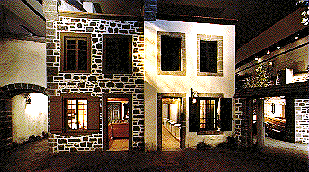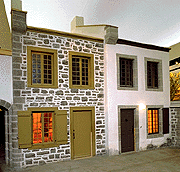Canada Hall
 The Cooper's
House
The Cooper's
House
A typical house in town had two or three storeys, shuttered windows and a high dormered roof. Its exterior stone walls were usually coated with whitewashed mortar. While wooden houses became increasingly rare in Quebec for fear of fire, Louisbourg, a town of merchants and fishermen, continued to build palisade-style wooden picket houses and warehouses. The common folk lived in one- or two-room dwellings, sometimes equipped with an attic or an attached shed or lean-to at the rear, where an artisan frequently had his shop. A single fireplace heated the entire building. The elite, on the other hand, owned larger stone houses which were almost mansions, with many wings and surrounding gardens and orchards.


The house on the right, adjacent to the cordwainer's, belongs to a wealthy artisan, the cooper, a skilled craftsman whose products were highly valued in the community. He manufactured barrels, which were used extensively to transport goods produced by farmers, the military, and commercial companies. This lucrative business employed several apprentices and artisans at a large workshop located in another part of town.

